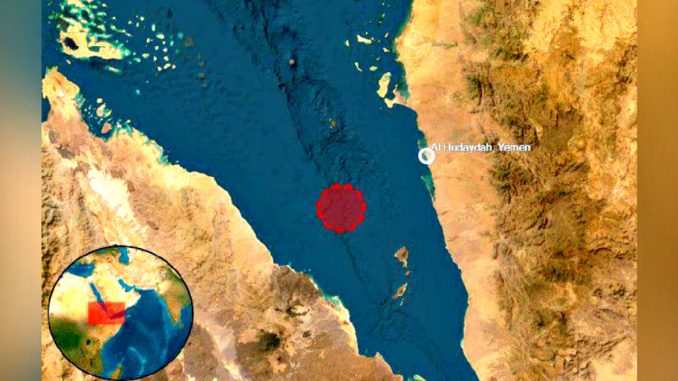
The place where the Magic Seas was attacked, near Yemen’s largest port/ Image Credit UKMTO.
| Published July 7, 2025
The calm of international shipping lanes was shattered once again this July as Houthi rebels launched a brazen and highly coordinated attack on the Magic Seas, a commercial bulk carrier transiting the Red Sea. Armed with drones, missiles, and fast-attack boats, the assault marked the most aggressive maritime strike in months and signaled a dramatic escalation in the region’s ongoing instability. Just hours later, Israel responded with retaliatory airstrikes on Yemeni port infrastructure, broadening a conflict that has now leapt from Gaza to the high seas. As the world watches trade routes threatened and tensions rise, the Red Sea has become more than a shipping lane—it is now a stage for global confrontation, raising urgent questions about security, diplomacy, and the fragility of international order.
🚢 Attacks & Escalation in the Red Sea Corridor
1. Magic Seas bulk carrier attacked — crew abandons ship
-
On July 6, 2025, the Greek-operated, Liberian-flagged Magic Seas was targeted approximately 51 nautical miles southwest of Hodeidah, Yemen.
-
Houthis (suspected) launched a coordinated assault: eight skiffs opened fire with small arms and RPGs, followed by missile strikes and four unmanned surface vessels—two struck the hull, causing a fire and flooding
-
The fire intensified, water ingress resumed, and the crew evacuated safely and were rescued by a passing vessel
-
Operators assessed this matched the Houthi targeting profile amid rising Red Sea tensions
2. Retaliatory Israeli airstrikes
-
In response on July 7, Israel struck Houthi-controlled ports—Hodeidah, Ras Isa, Salif—and a power station, also targeting the previously hijacked Galaxy Leader
-
Houthis reportedly used surface‑to‑air missiles to repel the strikes and even launched retaliatory missile/drone fire toward Israel
3. Another maritime attack near Hodeidah
-
On July 6, UKMTO warned of small boats opening fire (small arms + RPGs) on a second merchant vessel, about 51 nm off Hodeidah. The ship’s security team returned fire; the situation remained ongoing
 Implications
Implications
🔥 1. Geopolitical Implications
▸ Widening of the Middle East Conflict
-
The Houthi attack on the Magic Seas and Israel’s retaliatory strikes signal the expansion of the Israel–Hamas war into a broader regional conflict.
-
Yemen’s Houthi rebels have reinforced their image as part of the “Axis of Resistance” (with Iran, Hezbollah, and others), dragging new fronts into what began as a Gaza-centered war.
▸ Iran’s Strategic Posture
-
Though Iran denies direct command over the Houthis, Tehran’s support of the group puts it under increased international scrutiny. This incident may harden Western and Gulf countries’ stance toward Iranian-backed proxies.
▸ Pressure on U.S. and Allies
-
These attacks undermine the effectiveness of U.S.-led Operation Prosperity Guardian and the EU’s Operation Aspides — both created to secure Red Sea shipping.
-
Western powers may face calls to escalate counter-Houthi operations or shift their naval strategies altogether, raising the risk of direct confrontation.
💸 2. Economic Implications
▸ Shipping Disruptions & Rerouting
-
Many commercial vessels are already avoiding the Red Sea, opting for the much longer Cape of Good Hope route.
-
This leads to higher fuel costs, insurance premiums, delays, and increased prices for oil, grain, electronics, and other globally traded goods.
▸ Impact on Global Trade
-
Roughly 12% of global trade passes through the Red Sea. These attacks may create persistent uncertainty in logistics, triggering supply chain instability.
-
Companies may pass on added shipping costs to consumers, indirectly fueling inflation in importing nations.
▸ Energy Security Risks
-
Yemen is near the Bab el-Mandeb Strait, a chokepoint for oil and gas shipments from the Persian Gulf to Europe and the U.S.
-
Escalation threatens energy flow security, prompting importers to seek alternative (and more expensive) energy sources or routes.
⚔️ 3. Military and Security Implications
▸ Evolving Tactics
-
The Houthis used drones, missiles, and unmanned surface vessels (USVs) in a coordinated strike—showing increased tactical sophistication that resembles Iranian IRGC naval methods.
-
These tactics challenge conventional naval defenses and raise the bar for future maritime protection operations.
▸ Naval Escalation
-
More Western warships may be deployed to the Red Sea, increasing the likelihood of accidental engagements or deliberate retaliation.
-
Nations may bolster onboard security (armed guards, counter-drone tech), but the cost of maritime defense is rising fast.
🧭 4. Legal and Diplomatic Implications
▸ UN and Maritime Law
-
The deliberate targeting of commercial vessels could trigger further UN Security Council involvement, though diplomatic paralysis is likely due to U.S.–China–Russia divisions.
-
Shipping industry leaders and maritime law advocates may push for reclassifying Houthi actions as piracy or acts of war, allowing broader legal responses.
▸ Insurance & Liability
-
Maritime insurers will reclassify routes as “high-risk zones”, raising premiums and possibly denying coverage for unarmed ships in the area.
-
Legal liabilities and flag-state responsibilities could become a contentious issue, especially for crew safety and environmental damage.
🚨 5. Humanitarian Implications
▸ Seafarer Safety Crisis
-
Merchant mariners now face increased threats from missile and drone warfare, not just piracy. Morale and recruitment for commercial shipping may suffer.
-
Seafarers from countries like the Philippines, India, and Ukraine (major labor sources) face growing occupational danger, sparking demands for improved protections.
▸ Worsening Yemen Crisis
-
Israeli retaliatory strikes hit Yemen’s power stations and port infrastructure, worsening conditions in an already devastated nation.
-
Houthi control in the west of Yemen continues to block humanitarian aid, making civilian suffering worse amid fuel and food shortages.
 Overall Takeaway:
Overall Takeaway:
The July 2025 Houthi attacks in the Red Sea signal a dangerous escalation in both maritime security and regional conflict. What was once a contained insurgency has now become a strategic threat to global trade, energy routes, and geopolitical stability. The targeting of commercial vessels—combined with Israel’s retaliatory strikes—confirms that the Red Sea is now a frontline in a broader Middle East confrontation, directly tied to the Gaza war and Iranian proxy dynamics.
As shipping companies reroute vessels and nations reinforce naval deployments, it is clear that existing security operations are no longer enough. The conflict has exposed serious vulnerabilities in international maritime defense and has placed seafarers, global supply chains, and regional civilians at increased risk.
Ultimately, without sustained diplomatic intervention and regional de-escalation, the Red Sea will remain a flashpoint with global consequences—economically, militarily, and humanely. The world cannot afford to ignore this volatile convergence of war, trade, and politics.





Be the first to comment